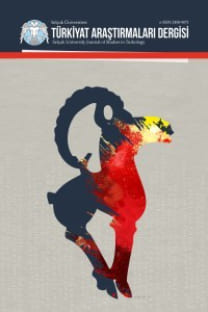“Güler” Redifli Gazellerin Karşılaştırılması
Divan şiirinin önemli bir tarafını oluşturan redif, gazelin bütününde ses ve âhenk açısındanyarar sağladığı gibi, muhtevaya da önemli oranda katkı sağlamaktadır. Bu katkının daha iyianlaşılabilmesi, müşterek redifli gazellerin tespit edilip karşılaştırılmasıyla mümkün olabilir.Bu nedenle “güler” redifli gazeller, inceleme konusu seçilmiştir.Araştırmalarımız sonucunda, Ahmedî, Ahmed Paşa, Necati Bey, Muhibbî, Âşık Çelebi,Pertev ve Enderunlu Hasan Yâver’in “güler” redifli gazel yazdığı tespit edilmiştir.Çalışmamızda, 14. yüzyılda bir, 15., 16. ve 18. yüzyıllarda ikişer tane olmak üzere tespit edilentoplam 7 “güler” redifli gazelin, muhteva ağırlıklı olmak üzere çeşitli açılardankarşılaştırılması yapılmıştır
Anahtar Kelimeler:
Karşılaştırmalı edebiyat, divan şiiri, redif, gazel.
Comparison of Ghazels with the Redif “Güler”
Redif makes up an important part of Divan poetry. It is beneficial for rhythm and harmony with respect to the wholeness of a ghazel. It also contributes to the content. To understand this contribution, ghazels with common redifs must be detected and compared. For this reason ghazels with the redif “güler” are chosen as a topic of research. As a result of researches it is understood that Ahmedî, Ahmed Paşa, Necati Bey, Muhibbî, Âşık Çelebi, Pertev and Enderunlu Hasan Yâver had written ghazels with the redif “güler”. There are seven ghazels of this kind. One of them belongs to the 14th century. There are two ghazels each belonging to the 15th, 16th and 18th centuries. This study aims to compare these ghazels in respect to different views mainly according to their contents.
Keywords:
Comparative literature, divan poetry, redif, ghazel,
- ISSN: 1300-5766
- Yayın Aralığı: Yılda 3 Sayı
- Başlangıç: 1994
- Yayıncı: Selçuk Üniversitesi
Sayıdaki Diğer Makaleler
“Güler” Redifli Gazellerin Karşılaştırılması
Dede Efendi’nin Yürük Semâîlerinin Usûl-Arûz Vezni İlişkisi Yönünden İncelenmesi
Esrârü’l-‘Ârifîn ve İmla Özellikleri Üzerine Bir Değerlendirme
Osmanlının Zor Yıllarında Rumeli Göçmenlerinin Türk Basınındaki Sesi: ‘Muhacir’ Gazetesi (1909-1910)
Tarih Yazıcılığından Tarih Felsefesine: Mehmet Ârif’in “Muhâkemeli Tarih” Anlayışı
Çuvaş Türkçesinde İkili Biçimler
